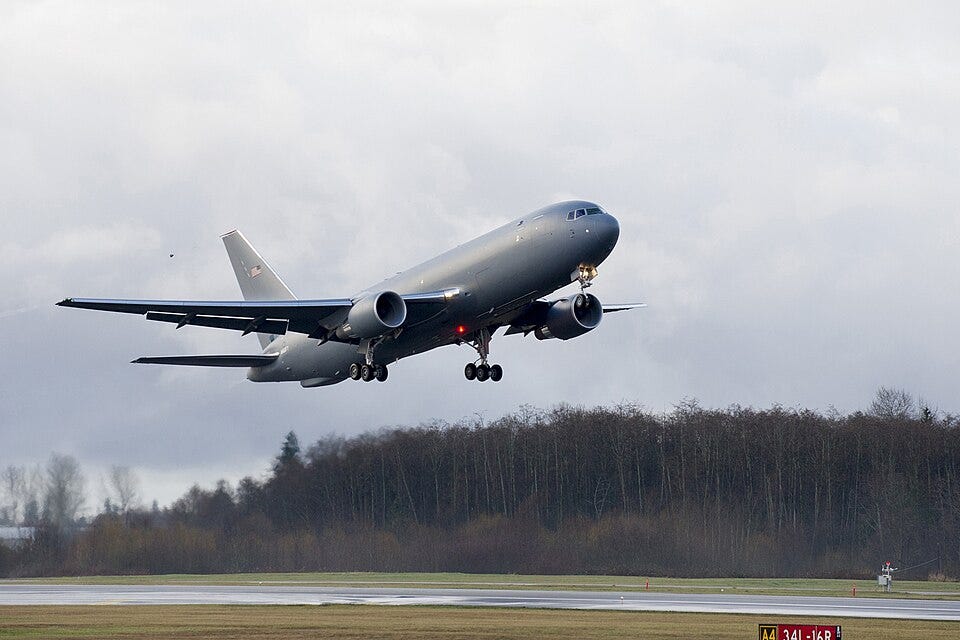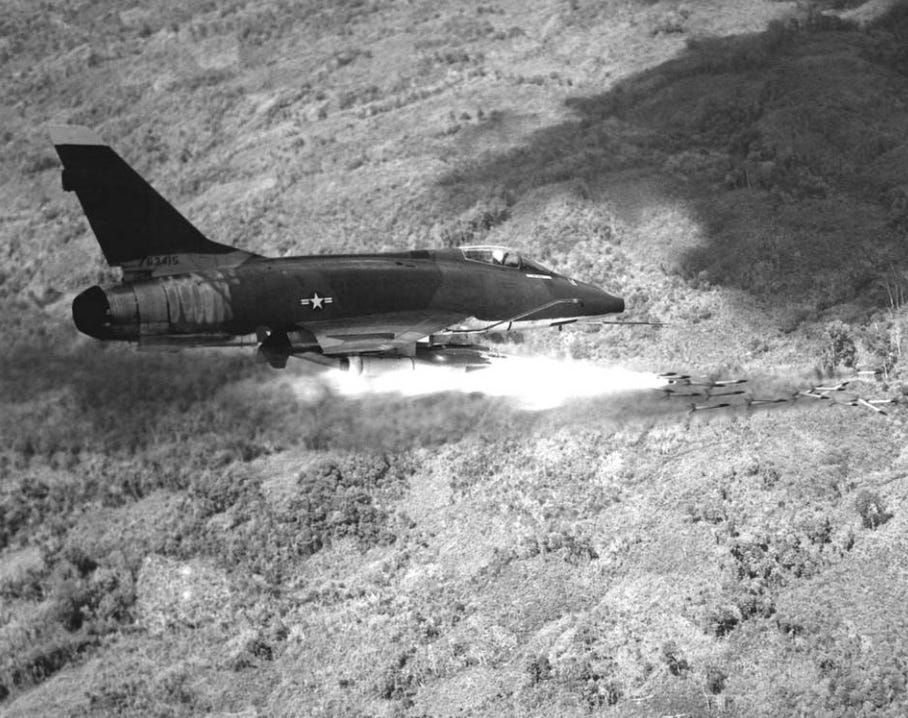KC-46A Pegasus Lifts Off: From Bumpy Ride to Big Win & the F-100 Finally Broke In
After years of headaches, delays, and everyone watching closely, both the KC-46A and the F-100 finally got their act together.
“I have 100 % confidence in [the Pegasus’] ability … The people that fly, fix and support it, love it. The people that refuel off it.”
— Mike Minihan, Commander of Air Mobility Command (USAF)
Before we get underway valued reader, picture this: you’ve just finished Tuesday’s briefing, the engines are cooling, and you’re already looking for the next flight plan. That’s exactly why I’m launching a new cadence—three issues every week. Tuesday and Thursday remain free for all aviators, but on Wednesdays we’re wheels-up for the Midweek Sortie, a members-only deep dive built to take you further than the public feed ever could. If you’re ready for an extra climb-out each week—packed with behind-the-scenes insights, untold aviation stories, and cockpit-level analysis—you’ll want to be onboard for the Wednesday sortie - we will begin our first every Midweek Sortie with a Thud, literally - it will be about Republic’s F-105. And now, onto the briefing:
Mission Briefing
You may recall when everyone referred to the KC-46A as the Air Force’s problem child? Well, it’s done a total 180—now it’s proving itself as a dependable workhorse with real global reach. The Pegasus isn’t just hitting its delivery numbers—it’s coming off the line smooth as can be now. That’s huge for Boeing and AMC, since this tanker is central to the Air Force’s go-anywhere plans.

Built for a Reason
In 2011, Boeing secured a major contract to replace the aging KC-135s—Cold War relics—with what would become the Pegasus. But man, it wasn’t smooth sailing. They faced numerous headaches, particularly with the Remote Vision System and the stubborn fuel boom, which resulted in several redesigns and incurred substantial penalties for Boeing. Still, after addressing several issues, they finally secured approval for the upgraded RVS 2.0 in 2024.
Now, the Pegasus is the real deal. It’s got a fly-by-wire boom and hose-and-drogue pods. It’s a tanker, a transport, and even a medevac all in one—and it can offload a massive amount of fuel while staying connected with secure data links for those next-gen command networks.
This is a significant development because those old KC-135s are now essentially museum pieces. However, with the Pegasus flying out of places like McConnell, Pease, and Altus, the Air Force has finally regained a modern refueling backbone, crucial for keeping us and our allies ready to deploy anywhere in the world.
Features: “Not Your Grandpa’s Tanker”
Once it’s entirely up and running, the KC-46A can refuel pretty much any jet set up for in-flight gas. It’s got a slick fly-by-wire boom for big planes and a hose-and-drogue system for everything else, so it’s ready for almost any mission.
Fuel can flow through the boom, drogue, or wing pods—and with the pods, it can top off multiple jets at once. The boom operator gets a panoramic view on big screens, watching every angle during refueling.
What’s impressive is the versatility. This jet can carry passengers, cargo, or serve as a flying hospital—all at the same time, if needed. With two heavy-duty engines, it can take off loaded with up to 18 pallets or 65,000 pounds of cargo, and you can mix in passengers too. Plus, it’s packed with defensive systems and secure comms, so it can handle itself, even when things get rough.
Like the folks at Boeing said:
“Built to meet the requirements of the U.S. Air Force and allies for the full spectrum of missions, the combat-ready KC-46 Pegasus air refueling plane delivers proven multi-mission capabilities today, and evolves to meet the needs of tomorrow.”
“Keeping Us (and Our Friends) in the Air”
The KC-46A is basically giving U.S. and allied air power a real shot in the arm. Instead of depending on those old tankers, we’ve now got a modern refueler that lets our jets stay in the air longer and reach places we couldn’t before, even if things get dicey. Additionally, it’s a significant advantage for working with our NATO and Pacific partners, as everyone can utilize the same refueling and communication setup. It’s like we’re all finally speaking the same language up there.
“The Road (or Sky) Ahead”
The Pegasus isn’t just up and running—it’s finally shaking off its old reputation and proving it belongs in the big leagues. But this comeback story isn’t over yet. With fresh upgrades and new tech on the horizon, the Pegasus is out to show it’s not just a fix for yesterday’s problems, but a real contender for tomorrow’s battles as more countries start eyeing it as their next tanker, the pressure is on. Now’s the moment for the KC-46A to turn its hard-won lessons into lasting impact and keep writing its redemption story at the heart of the world’s air operations.
This Week in Aviation History
Many may have ever wondered why the F-100 happened when it did. Well, back in the early ’50s, the U.S. was in a real hurry—Cold War nerves and all that. The YF-100A took off seven months ahead of schedule, and despite having a less powerful engine, it still managed to break the sound barrier. Basically, we needed a supersonic jet fast, and North American delivered, even if it meant ironing out some kinks later.”
But here’s the catch: those first F-100s were a handful—lots of crashes, mechanical headaches, and design quirks. The Air Force even had to ground the fleet for a bit. Still, every fix and upgrade, such as the F-100C and F-100D models, taught engineers a great deal about what worked and what didn’t in high-speed jets.
It mattered because, despite all the bumps, the F-100 pushed American aviation into the supersonic era and paved the way for safer, more advanced fighters. Progress isn’t always smooth, but man, does it move fast when you’ve got jet fuel in your veins.
Under the Hood and Beyond: F-100C Super Sabre’s Features
The F-100C Super Sabre got some muscle. Wingspan’s about 39 feet, length just over 54, and it stands as tall as a one-story house—16 feet. Fully loaded, she weighs almost 38,000 pounds. Up front, she’s packing four 20mm cannons, can haul a couple of Sidewinders or Bulldogs, rockets, and up to 7,000 pounds of bombs—plenty of ways to make an impression.
Under the hood, it’s a Pratt & Whitney J57 engine with afterburner, pushing out 16,000 pounds of thrust—enough to send you screaming along at just over 926 miles per hour, nearly one-and-a-half times the speed of sound. She cruises easily at around 590 mph, can fly close to 2,000 miles on a tank, and tops out at 55,000 feet—higher than most commercial jets. Back in the day, she cost about $700,000, but it is all worth it in speed and firepower.”
Pushing Limits, Inspiring Legends
The North American F-100 Super Sabre was the first jet that could really break the sound barrier, and that was a huge deal. Sure, it had a reputation for being a handful—lots of pilots will tell you about its sketchy handling and more than a few close calls.
But here’s the thing: every problem with the F-100 taught us something new. All those hard lessons pushed engineers to create smarter, safer, and faster jets, ultimately leading to legends like the F-104, F-15, F-18, and even the F-22.
So, even though the Super Sabre’s own service record was a bit rough around the edges, it was a trailblazer. Its stumbles forced everyone to up their game, paving the way for the breakthroughs in speed, maneuvering, and dogfighting that shaped modern air combat. The F-100 turned its challenges into progress, and you can see its fingerprints all over the jets we fly today.
In Case You Missed It
The NASA/Lockheed X-59 has flown:
Photo Outlet
Every issue of Hangar Flying with Tog gets you a free image that I’ve taken at airshows:
Feel free to use these photos however you like, if you choose to tag me, I am @pilotphotog on all social platforms. Thanks!
Post Flight Debrief
Like what you’re reading? Stay in the loop by signing up below—it’s quick, easy, and always free.
This newsletter will always be free for everyone, but if you want to go further, support the mission, and unlock bonus content like the Midweek Sortie, consider becoming a paid subscriber.
Your support keeps this flight crew flying—and I couldn’t do it without you.
– Tog




